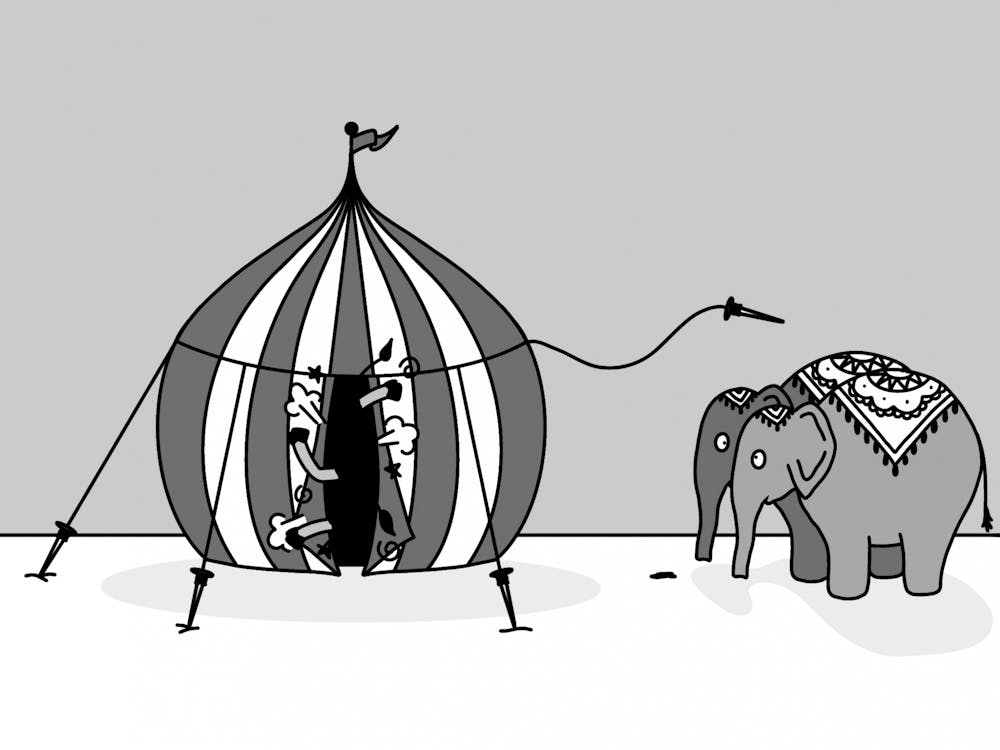Under the constraints of the United States' two-party system, the Democratic Party must build a strong united front in order to win elections and gain power. Yet, as conservative Democrats and democratic socialists are being elected at the same time, the party is beginning to rip apart at the seams.
In a recent interview with “New York Magazine,” Rep. Alexandria Ocasio-Cortez, D-N.Y., was asked about her role in Congress under a hypothetical Joe Biden presidency, and she pointed out that in any other country she would not belong to the same political party as Biden. She also made the point that Democrats might have “too big of a tent.”
And she’s right.
Canada, for example, had a federal election in October 2019 in which five parties won seats in the Canadian Parliament. In comparison, the United States hasn’t elected a single House member who ran on the ticket of a major party other than the Democratic Party or Republican Party since Franklin Roosevelt Jr. was elected to the House of Representatives as a Liberal in 1949.
The Democratic Party is the perfect example of a party trying to pitch a huge tent in order to win elections.
To be fair, it has worked to a certain extent. In the 2018 midterm elections, Democrats took control of the House of Representatives by expanding their coalition to include more Americans, especially suburban women.
There’s nothing wrong with electing moderates in swing districts in order to give Democrats the majority. In fact, I think the country is better off because of it. The problem arises when Democratic House members in safe seats start opposing the party’s platform just as much as the swing-seat moderates.
Rep. Dan Lipinski, for example, has represented Illinois’s 3rd Congressional District since 2005. Due to his voting record, he is generally regarded by Democrats as one of the most conservative House Democrats. He is anti-abortion, opposes same-sex marriage and voted against the Affordable Care Act. He even refused to endorse President Obama’s reelection bid in 2012.
The Cook Partisan Voting Index, a measurement of how strongly U.S. congressional districts lean towards the Democratic Party or Republican Party compared to the country as a whole, rated the district as “D-plus-6,” meaning that, in theory, the average Democratic candidate for Congress in the district would outperform the national Democratic result by six percentage points. In other words, they would be more liberal.
Illinois’s 3rd Congressional District is not a swing district, but Lipinski is allowed to oppose the party platform on key issues without any serious repercussions from the Democratic Congressional Campaign Committee in order to maintain a united Democratic front.
On the other end of the spectrum, there’s Rep. Rashida Tlaib. She represents Michigan’s 13th Congressional District, which was rated by the Cook Partisan Voting Index as D-plus-32, and is a member of the Democratic Socialists of America.
She, like Lipinksi, is somewhat infamous for voting against the party on key issues, but, unlike Lipinski, her opposition comes from the fact that she is further left than most of the Democratic caucus. Tlaib is in favor of a one-state solution to the Israeli-Palestinian conflict, was an early supporter of abolishing the U.S. Immigration Customs Enforcement agency and argued for President Trump’s impeachment on her first day in Congress.
To win in America’s two-party system, the Democratic Party does whatever it can to win and maintain a House majority. If the U.S. had a multi-party system, there is no doubt that Reps. Lipinski and Tlaib would be members of different parties. It’s also likely that neither would belong to the same party as House Speaker Nancy Pelosi.
However, because the Democratic Party is stretched to include every voter possible, all three remain locked together in a party with increasing strife between its conservative, moderate and progressive factions.
These growing divisions are also evident when looking at the Democratic Party’s presidential primary. Among the front-runners, Sens. Bernie Sanders and Elizabeth Warren represent a more progressive path forward for the party than former Vice President Joe Biden or former South Bend, Indiana, Mayor Pete Buttigieg.
As the candidates compete with one another in an attempt to become the party’s presidential nominee, tensions are rising between party factions that must be prepared to unite after the primary if they want any hope of defeating President Trump in November.
It appears that the Democratic Party’s coalition has become too broad to be sustained for much longer, but the two-party system all but guarantees a Republican victory without opposition from a singular, and fairly broad, party of the left.
So, yes, the Democratic Party’s tent is too big, but perhaps that’s the only way, at least in the current system, to win.
Jerrett Alexander (he/him) is a freshman studying international relations and environmental sustainability. He currently sits on the Bloomington Commission on Sustainability.





